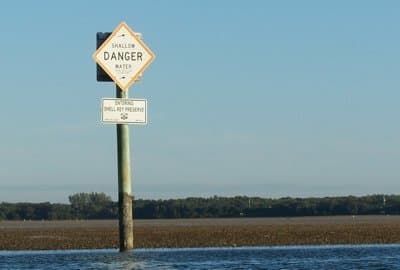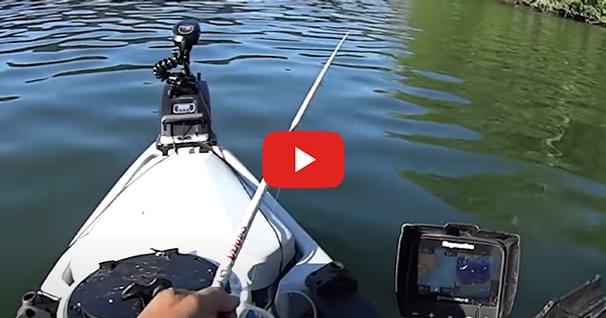The Stealth Advantage
Like many of you, I often record traditional fishing shows on TV and then glean them in "ffwd" to snag any useful tips that I can that might apply to our sport - paddle fishing. Recently, one of those shows focused on things that boaters can do to reduce noise. It reminded me of the advantages of paddle fishing, and has prompted me to revisit my roots. The ability we have of being able to launch pretty much anywhere it's legal and we can find parking is certainly one advantage. But, the real edge we have over the power boat crowd is stealth. We can get much closer to our target because we travel quieter, and cast a much smaller profile than power boats.
It's time to get a little loud about being very quiet.
CROSSING OVER:
About the only difference between paddle fishing techniques and power boat fishing techniques involve the vessel. We use pretty much the same rods, reels, tackle, and lures. So, crossing over from the "dark side" isn't much of a journey at all. And, there is certainly no shame in using either method. One thing that I have seen is that may boaters approach fishing a lot differently after fishing from plastic. Many show more respect for the resource and those that we share it with as a result. And, when they're back on their boat, they are a lot more aware of how noises of any kind can spook fish. They've learned the value of stealth.
AFTER ALL, IT'S JUST TRANSPORTATION:
Fishing while still afloat is certainly a great way to sneak up on fish. But never rule out the other options available to you. Here in Florida, the shallow inshore waters are perfect for maximizing the benefits offered by paddle fishing. One of the main benefits is that a paddle craft can simply go where other vessels only dream. Kayaks and canoes are simply a means of transportation to get to better angling locations. Once there, you can wade, or even beach your craft and walk the shoreline. At a recent gathering of Tampa Bay anglers, I witnessed this first hand. At a very low tide, some fish found themselves trapped in a hole created by the retreating tide, unable to escape due to the exposed real estate. Some buddies that knew where this hole would appear under such conditions paddled up to it, beached their boats, walked across some mud flats, and then made productive casts to the landlocked fish. In the picture below, you can see the exposed flats. What you can't see are the anglers way off in the background, having a blast!

Not long after snapping this picture, my wife and I beached our boats on a nearby sandbar, and walked the water's edge, tossing lures. As we walked on this new dry land, we caught a number of fish because we could move around to make casts very quickly. No, we didn't catch these fish from our kayaks, but the kayak certainly played a huge part in our success.
FISH MENTALITY:
Fish are simple creatures. They eat, breed, and try not to be eaten. They don't reason, or try to figure things out. Unlike teenagers in a movie involving a haunted house, they don't investigate strange noises, they leave the area. Sounds don't bother them unless the sound isn't normal … like a paddle slap or an anchor making an ungraceful landing in the tank well. Sound/vibrations travel much quicker in water than they do on land, so it pays to be quiet. In many cases, you can be rewarded more by what you DON'T do than what you do. The more you can do to make your self invisible to the fish, then more likely you are to catch one.
PADDLE NOISE:
Your paddle is your engine, and here's where you have a significant advantage over someone in a boat. Your engine is relatively quiet. You can improve on that by simply paying attention to your strokes as you enter a fishy address. Quietly insert the blade in the water instead of slapping at it. And more importantly, once you've entered the desired area, take special care when putting the paddle in to the paddle holder.
HULL SLAP:
As you test drive new boats on the market, pay attention to this. Some are quiet while in motion, but while at rest, small waves can create hull slap. This becomes important if you're anchored up on a grass flat. You may be very quiet, but your boat notifies all finned creatures that something different has entered their world. Rather than reason and investigate, they retreat. Fish will always err on the side of safety. That leaves you sitting dead quiet on an empty grass flat, alone.
WADING:
This is a great way to sneak up on fish. Many paddle anglers (myself included) often forget about this tactic. As long as you aren't high stepping to get to the desired location, chances are you'll catch the fish off guard. Your kayak now turns into a floating tackle caddy.
LIVE WELLS / AERATORS:
For most of us, fishing with live bait is a hassle. Lures are without question the most popular way to go. But, few can argue that feeding a fish the real thing is normally more productive. The major drawback is solving the riddle "how do I keep live bait alive?" If you're on land, battery operated aerators are the answer. But, put a tiny vibrating noise maker on a kayak, and all of a sudden you have a 13' vibrating noise maker. I can offer 2 solutions, I know there are more.
- One is to wrap the aerator in some sort of foam. This will help minimize the transfer of vibrations to the boat. This method will probably be the easiest to execute.
- Another way is to keep bait in a flow-through bait bucket. Before paddling around you can gently place it in the tank well. When you're ready to fish, gently ease it over the side and let it trail behind the boat. Don't wait too long to give your bait another drink though. Remember, they're taking lots of oxygen form the water, and the warmer the water, the less oxygen it will contain. Make sure the tether line to the bait bucket is long enough that it clears the bow/stern of the boat. Having that bucket repeatedly slam against your boat will surely send the fish off in every direction.
PRESENTATION:
It's sunrise. The water is like glass, not a ripple for 50 yards in any direction. You were very quiet on your journey here - the fish haven't seen or heard you yet. You heave your favorite lure out over the water. It lands with a mighty splash. You sit there as fish go screaming under your boat, scared to death. Yes, I've had this happen to me, and it's real hard to recover from that. If the water is super slick, then using a smaller bait that lands gently is certainly the way to start working an area. If you see some surface activity, then maybe a top water lure is in order. Still, you must practice making a gentle cast. I've also found that if you do make a loud splash, don't move the lure immediately; the fish will associate your lure with the cause of the disturbance, and will ignore it. If a fish was merely startled, it may resume feeding once it feels the threat has passed. At that point your lure can now be mistaken for a meal.
WORKING A GROUP OF SCHOOLING FISH:
If you happen across a school of feeding fish, resist that urge to cast into the middle of them. This will most assuredly spook them all. If the sound of something foreign crashing over their head wasn't enough, the feel of fishing line against their bodies will guarantee their disappearance. Instead, cast short of where you think the edge of the school is. Chances are, there are members of the group there as well, and some of the fish suspended lower in the water column may rise up to check out your lure in an attempt to be the first ones on the scene. Schooling fish are competitive for food (that's good), but they also rely on all of the senses of the group to help them find food avoid danger (that's bad for us).
FLY FISHING:
When it comes to natural presentation, nothing competes with fly fishing. A fly will land very naturally on the water, which doesn't spook most fish. When it's worked, it looks very natural in the water. However, fly fishing from a kayak or canoe can be tricky. The solution can be as simple as getting out of your boat and wading, or walking the shoreline. I've often heard that if you ever want to stop catching fish, pick up a fly rod. Sure, it's more of a challenge, but in some cases, it's the only method that will produce. Currently, today, as of this writing, I don't fly fish. However, many of my buddies do. And, they post pictures of some impressive catches. Many times they're catching while other people in the same area are merely casting. It makes me think about embracing that art, and yes, fly fishing is an art.
So, next time you hit the water, pay attention to the noises you make. Then, consciously make efforts to eliminate them. Practice makes perfect, and repeated actions become habits. Time to learn some good habits for a change.
THOUGHT FOR THE DAY: Sometimes the best way to get someone's attention is to whisper …
See you out on the water...
"Many men go fishing all of their lives without knowing that it is not fish they are after"
~ Henry David Thoreau
Related Articles
Kayak Catfish does some trolling with crappie magnets to catch some catfish bait.
The true story and life-saving lessons of Adam Irino’s very strange day. August 31, 2019 was shaping up…
For most of us, it's still summer. It's hot, it's humid, it WILL rain at 4:32 PM everyday, normally…
I got a good fish on a crank bait bite first thing this morning and as I go to lift it, the fish jumps…



